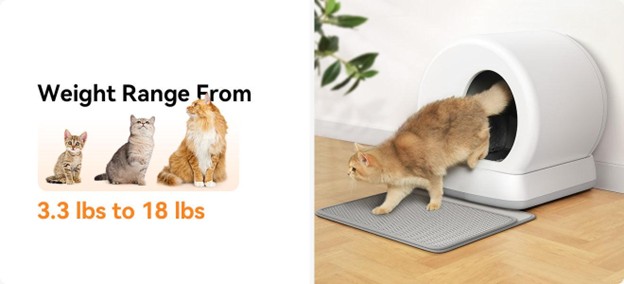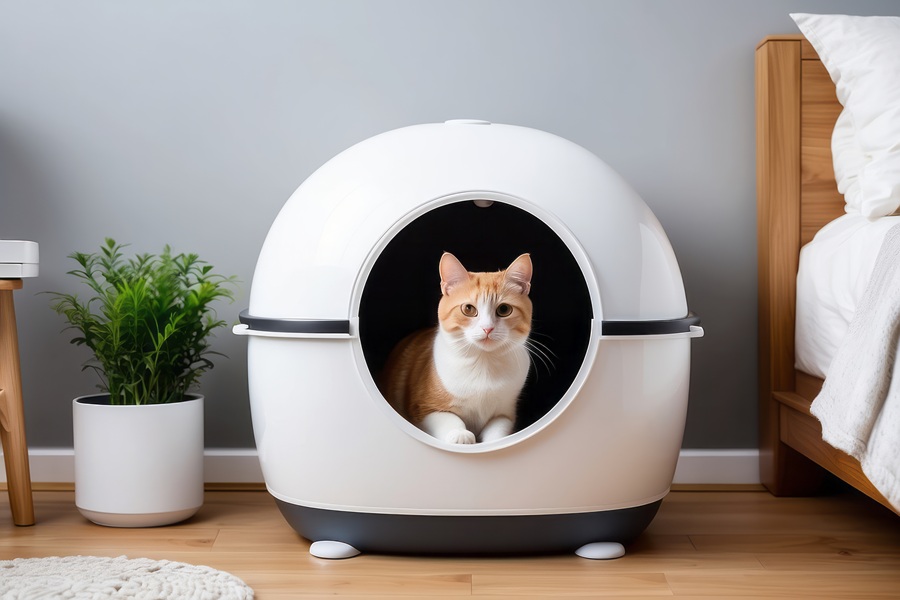Can automatic litter boxes handle multi-cat homes?
Automatic litter boxes can effectively transform multi-cat litter management from a daily burden into an efficient, stress-free routine that benefits both pets and their owners
MANAGING MULTIPLE LITTER boxes in a multi-cat household can feel like a never-ending chore, with the average cat parent spending up to 30 minutes daily on litter box maintenance. With 85% of multi-cat households reporting litter box-related stress, many wonder if automatic litter boxes could be the solution. Recent surveys show that homes with multiple cats face unique challenges, from increased cleaning frequency to difficulties monitoring individual cat health. As automatic litter boxes gain popularity, the key question remains: can these high-tech solutions effectively handle the demands of multiple cats? Before making the investment, cat parents need to understand crucial factors like waste capacity limits, usage tracking capabilities, and proper setup requirements that can make or break success in a multi-cat environment.
The Unique Challenges of Multi-Cat Litter Box Management
The traditional “n+1” rule, which recommends having one more litter box than the number of cats in your household, exists for compelling reasons. Cats are inherently territorial creatures, and sharing elimination spaces can create significant stress. Even bonded cats often prefer their own designated bathroom areas, making proper litter box management crucial for maintaining harmony. This territorial behavior becomes more pronounced in multi-cat environments, where dominant cats may guard preferred boxes or prevent others from accessing certain areas.

Beyond territorial concerns, managing multiple cats’ bathroom habits presents unique health monitoring challenges. When several cats share litter boxes, it becomes increasingly difficult to track individual elimination patterns – a crucial indicator of potential health issues like urinary tract infections or digestive problems. Changes in frequency, consistency, or volume often go unnoticed until problems become severe, particularly in households with three or more cats.
Stress-related elimination issues also multiply in crowded setups. When cats feel their territory is threatened or litter boxes are too close together, they may develop anxiety-driven behaviors like eliminating outside the box or excessive covering. These behaviors can cascade through the household, as one cat’s stress often affects others, potentially leading to widespread house-soiling problems. Understanding these complex dynamics is essential for creating an effective litter box management strategy that promotes both physical and emotional wellbeing for all cats in the household.
Automatic Litter Box Capacity for Multi-Cat Households
Understanding Waste Storage Limits
Automatic litter boxes feature varying waste drawer capacities, typically ranging from 4 to 14 liters. While single-cat households might empty these drawers weekly, multi-cat environments require more frequent maintenance. The average cat produces approximately 1-2 cups of waste daily, making capacity calculations crucial. Most advanced models, like the Meowant Smart-Track system, utilize weight-sensing technology to trigger cleaning cycles, offering more efficient waste management than timer-based systems. This smart detection helps prevent overflow issues common in high-traffic boxes, though drawer capacity remains a limiting factor.
Solutions for High-Volume Waste
To maximize efficiency in multi-cat households, adjust cleaning cycle frequency based on usage patterns rather than preset intervals. Consider implementing a dual waste management system: connect automatic boxes to sealed waste collection bins or explore compatible waste collection accessories that extend capacity. Leading high-capacity models feature compression technology that compacts waste, effectively doubling storage capacity. For optimal performance, position units near ventilated areas and establish a regular maintenance schedule aligned with your cats’ usage patterns. Some users successfully pair automatic boxes with odor-control systems to extend time between emptying.

Multi-Cat Setup Strategies
Optimal Number of Automatic Units
While the traditional n+1 rule suggests three boxes for two cats, automatic litter boxes can serve multiple cats more efficiently due to their frequent cleaning cycles. For most households, start with one automatic unit per two cats, maintaining at least one traditional box during the transition period. Strategic placement becomes crucial – position automatic units in different zones of your home, ideally on separate floors or opposite ends of living spaces. Keep units away from high-traffic areas, food bowls, and sleeping spots to prevent territorial disputes. Consider your cats’ established bathroom patterns when selecting locations, as dramatic changes can increase stress and reduce adoption success.
Transitioning Multiple Cats Successfully
Introduce automatic litter boxes gradually over 2-4 weeks. Begin by placing the new unit unplugged next to existing boxes, allowing cats to investigate naturally. Transfer small amounts of used litter from traditional boxes to the automatic unit to maintain familiar scents. Once cats show interest, activate basic functions like the rake or cleaning cycle during low-stress periods. For anxious cats, use calming pheromone diffusers near new units and maintain consistent daily routines. Monitor each cat’s response individually, as some may adapt quickly while others need extended adjustment periods. If resistance occurs, slow the transition and ensure easy access to familiar boxes until all cats demonstrate comfortable usage patterns.
Tracking Litter Box Usage Among Multiple Cats
Why Usage Monitoring Matters
Monitoring individual litter box usage provides critical insights into your cats’ health and wellbeing. Changes in elimination patterns often signal underlying health issues before other symptoms appear. For instance, increased urination frequency might indicate diabetes or kidney disease, while reduced usage could suggest urinary blockages requiring immediate attention. In multi-cat households, tracking usage patterns helps identify resource guarding behaviors where dominant cats may prevent others from accessing boxes. Understanding each cat’s baseline habits – including preferred times, locations, and frequency – enables quick identification of concerning changes and helps maintain harmonious sharing of facilities.

Practical Tracking Solutions
Modern automatic litter boxes offer sophisticated tracking capabilities through integrated apps and WiFi connectivity. Advanced models use artificial intelligence to distinguish between cats based on weight profiles and behavior patterns, sending real-time alerts for unusual activities. RFID-enabled systems can identify individual cats through collar tags or microchips, creating detailed usage logs for each pet. For traditional setups, maintain a daily observation log noting times, locations, and any unusual behaviors. Consider installing small cameras near litter areas to review footage when behavior changes occur. Combine these tracking methods with regular vet check-ups to establish comprehensive health monitoring for your multi-cat household.
Smart Solutions for Multi-Cat Litter Management
Automatic litter boxes can effectively serve multi-cat households when properly implemented. Success hinges on understanding your specific household needs and selecting systems with adequate capacity and tracking features. For optimal results, ensure your setup includes sufficient units based on cat count, strategic placement throughout your home, and proper transition time. Consider supplementing with traditional boxes during the adjustment period and utilize available tracking technology to monitor individual cat health. Before investing, evaluate waste capacity requirements, space constraints, and your cats’ personalities. Remember that even the most advanced automatic system requires regular maintenance and monitoring. Start with one unit per two cats, maintain consistent cleaning schedules, and gradually expand your automatic litter box network as needed. By following these guidelines and remaining attentive to your cats’ adjustment, automatic litter boxes can transform multi-cat litter management from a daily burden into an efficient, stress-free routine that benefits both pets and their owners.

